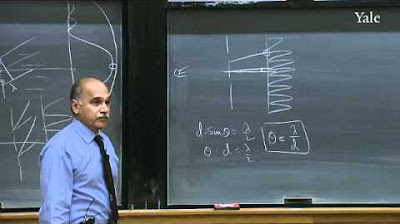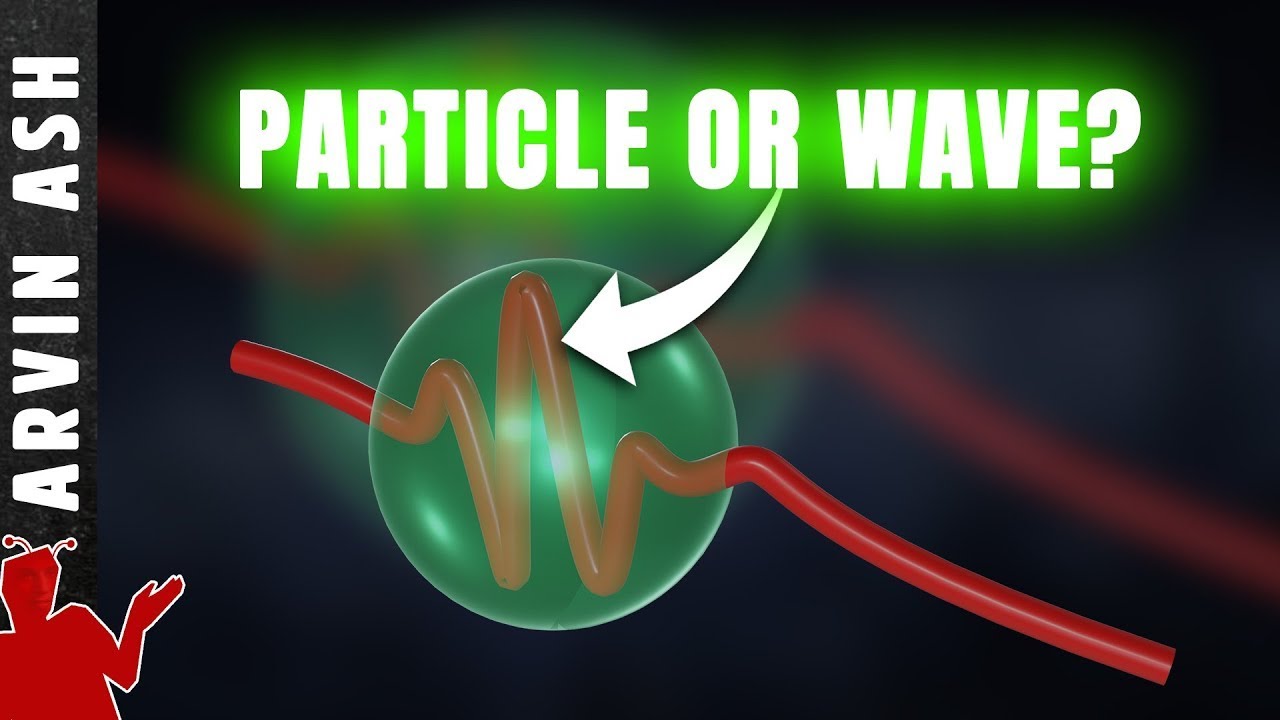Boy, Was I Wrong! How the Delayed Choice Quantum Eraser Really works
TLDRThe video script explores the concept of retrocausality in quantum mechanics, specifically discussing the Delayed Choice Quantum Eraser experiment. Initially, the experiment's authors and several YouTubers interpreted the results as suggesting the future could affect the past. However, after a viewer with a PhD in quantum optics clarified the details, it was admitted that this interpretation was incorrect. The video aims to simplify the experiment for viewers with a basic understanding of science. It explains that the retrocausal conclusion requires a non-standard interpretation of quantum mechanics, assuming a photon is either a particle or a wave from the moment it leaves the source. The standard interpretation involves a photon in flight being in a superposition of states, only becoming a particle upon measurement. The script also debunks common misconceptions about the double-slit experiment and explains the true workings of the Delayed Choice Quantum Eraser, emphasizing that it does not imply changing the past but rather selecting a subsample of data in the present that corresponds to a specific outcome in the future.
Takeaways
- 📜 The original 1998 paper on the Delayed Choice Quantum Eraser experiment was misinterpreted by some, including the author of the video, as implying retrocausality (future affecting the past).
- 👓 A viewer with a PhD in quantum optics clarified the experiment for the author, emphasizing the importance of understanding the details of quantum mechanics.
- 🚫 The retrocausal interpretation is incorrect if one adheres to the standard interpretation of quantum mechanics, where a photon in flight is in a superposition of states until measured.
- 🌟 The act of measurement in quantum mechanics causes a wave function collapse, turning a wave into a localized particle, which is not due to observation or consciousness.
- 🌈 The double-slit experiment shows that without measurement, an interference pattern emerges, indicating the wave-like behavior of particles. Measurement changes this to a particle-like pattern.
- 📉 The Delayed Choice Quantum Eraser experiment is an extension of the double-slit experiment, introducing entanglement and the concept of 'erasing' which-way information.
- 🤔 The confusion around retrocausality arises from the presentation of the experiment, suggesting that future measurement outcomes influence past events.
- 🔍 In reality, the 'eraser' part of the experiment does not change the past; it allows for the selection of specific subsets of data from the past, based on future measurements.
- 🧲 The phenomenon of entanglement allows for the correlation between particles at detector D1 and those at other detectors, enabling the recovery of interference patterns from a non-interference pattern.
- 🔄 The combined patterns from all detectors (D2, D3, D4, D5) result in the same pattern as at D1, indicating that the future does not change the past, but rather, we select data from it.
- 🔗 The Delayed Choice Quantum Eraser experiment is a complex demonstration of quantum mechanics principles, emphasizing the role of measurement and the superposition of states.
Q & A
What is the main focus of the original 1998 paper on the Delayed Choice Quantum Eraser experiment?
-The original 1998 paper focused on the concept of retrocausality, which suggests that the future can affect the past, within the context of quantum mechanics.
Why did the author admit their interpretation of the experiment as implying retrocausality was incorrect?
-The author admitted their error after a viewer with a PhD in quantum optics clarified that the standard interpretation of quantum mechanics does not support retrocausality.
What is the significance of the double-slit experiment in understanding the Delayed Choice Quantum Eraser?
-The double-slit experiment is fundamental because it demonstrates the wave-particle duality of quantum objects and the concept of wave collapse, which are key to understanding the Delayed Choice Quantum Eraser.
How does the act of measurement in the double-slit experiment affect the outcome?
-Measurement in the double-slit experiment causes the wave function of the photon to collapse, resulting in a particle-like behavior and eliminating the interference pattern that would be observed without measurement.
What is the role of the Barium Borate (BBO) crystal in the Delayed Choice Quantum Eraser experiment?
-The BBO crystal is used to split a single photon into a pair of entangled photons, which is a critical step in the experiment that effectively creates a measurement and collapses the photon's wave function.
Why does the pattern at detector 1 (D1) in the Delayed Choice Quantum Eraser experiment not change to match the interference patterns at detectors 4 and 5?
-The pattern at D1 does not change because the path information of the photons reaching D1 is already known, and thus the wave function has collapsed, resulting in a non-interference pattern that is not influenced by future events at other detectors.
How does the process of entanglement allow for the 'erasure' of which-way information in the Delayed Choice Quantum Eraser experiment?
-Entanglement creates a correlation between the photon pairs, allowing scientists to identify which partner photon from D1 corresponds to a photon at another detector. This process effectively 'erases' the which-way information when looking at specific subsets of the data.
What is the misleading illustration commonly shown about the double-slit experiment that the author seeks to debunk?
-The misleading illustration is the depiction of two clean lines of photons on the screen when a detector measures the path. In reality, the photons spread out in a fuzzy collection of dots due to enhanced diffraction when the slits are narrow.
Why does the author emphasize that the quantum eraser does not change the past but rather involves selecting a subsample of data in the future?
-The author emphasizes this to clarify that the experiment does not support retrocausality. Instead, it demonstrates that by selecting specific subsets of photons based on their entangled partners, scientists can observe interference patterns, but these selections do not alter the original data set created in the past.
What is the term used to describe the phenomenon where a quantum system's wave function appears to 'collapse' due to interaction with the environment?
-The term used is 'decoherence', which is a process that helps explain how quantum systems transition from quantum to classical behavior.
How does the author's discussion on the Delayed Choice Quantum Eraser experiment contribute to our understanding of quantum mechanics?
-The author's discussion helps clarify misconceptions about retrocausality and reinforces the principles of quantum superposition and entanglement. It also provides a deeper understanding of how measurement affects quantum systems and the role of observer selection in interpreting experimental results.
Outlines
🧐 Understanding Retrocausality and Quantum Mechanics
The first paragraph discusses the concept of retrocausality and its implications in quantum physics, specifically in the context of the Delayed Choice Quantum Eraser experiment. The author admits to an initial misunderstanding of the experiment's results and acknowledges the need for a more nuanced understanding of quantum mechanics. The paragraph also highlights the importance of considering the superposition of states in quantum objects, such as photons, and how measurement affects their behavior. The author promises to simplify and clarify the experiment for viewers with a basic science background.
🌌 The Double Slit Experiment and Wave-Particle Duality
The second paragraph delves into the double slit experiment, which is foundational to understanding the Delayed Choice Quantum Eraser. It explains how photons, when not measured, create an interference pattern indicative of wave-like behavior. However, when measurement is introduced, the pattern changes to one that resembles particle-like behavior. The author emphasizes the role of quantum mechanics in this change, dispelling misconceptions about consciousness affecting reality. The paragraph also corrects a common misconception about the double slit experiment's outcome when detectors are used.
🔍 The Delayed Choice Quantum Eraser and Entanglement
The third paragraph provides a detailed explanation of the Delayed Choice Quantum Eraser experiment, which expands upon the double slit experiment. It describes how a Barium Borate (BBO) crystal is used to split photons into entangled pairs, effectively 'measuring' them and causing wave function collapse. The paragraph clarifies that the presence of entanglement allows for the manipulation of which-way information, leading to the creation of interference patterns without retrocausality. The author dispels the myth of retrocausality by explaining that the experiment's outcomes are due to the selection of specific photon subsets based on their entanglement with other detectors. The conclusion reinforces the idea that the future cannot alter the past, only the interpretation of past data.
Mindmap
Keywords
💡Delayed Choice Quantum Eraser
💡Retrocausality
💡Quantum Optics
💡Superposition
💡Wave-Particle Duality
💡Entanglement
💡Wave Function Collapse
💡Decoherence
💡Barium Borate (BBO) Crystal
💡Beam Splitters
💡Interference Pattern
Highlights
The original 1998 paper on the Delayed Choice Quantum Eraser experiment suggested retrocausality, where future events could affect the past.
The author admits to a mistake in interpreting the experiment's results as implying retrocausality.
A viewer with a PhD in quantum optics clarified the experiment, emphasizing the importance of understanding the details.
The retrocausal interpretation is incorrect if one considers the standard interpretation of quantum mechanics, where a photon in flight is in a superposition of states.
The double slit experiment shows that quantum objects behave as waves until measured, at which point their wave function collapses, appearing as particles.
The act of measuring in quantum experiments affects the outcome, leading to various interpretations about consciousness and reality.
Quantum objects are waves that localize upon interaction with a measuring device, a phenomenon known as wave collapse.
The Delayed Choice Quantum Eraser experiment is a more complex version of the double slit experiment, often misunderstood.
A common misleading illustration of the double slit experiment is debunked, explaining the actual distribution of photons.
The Delayed Choice Quantum Eraser uses a Barium Borate (BBO) crystal to split photons into entangled pairs, effectively measuring the photon's path.
The creation of entangled photons in the Delayed Choice Quantum Eraser results in the photon's wave function collapse, making it behave as a particle.
The 'eraser' part of the experiment merges the beams from the two slits, erasing the which-way information and resulting in interference patterns.
The perceived retrocausality is a confusion arising from how the experiment is presented, suggesting future events influence past measurements.
The actual patterns observed at detector 1 are unaffected by the quantum eraser; scientists select subsets of photons to match patterns at other detectors.
Entanglement allows scientists to identify which partner photons from other detectors correspond to those at detector 1.
The quantum eraser does not change the past but allows for the selection of specific data subsets in the future.
Combining patterns from all detectors results in the same pattern as at detector 1, indicating no change to the past measurements.
The future cannot alter the present, only the selection of past data can influence future outcomes.
Transcripts
Browse More Related Video

Why don't quantum effects occur in large objects? double slit experiment with tennis balls

20. Quantum Mechanics II

Quantum Entanglement & Spooky Action at a Distance

Are Photons & Electrons Particles or Waves? Make up your mind god!

Parallel Worlds Probably Exist. Here’s Why

Does the Universe Create Itself?
5.0 / 5 (0 votes)
Thanks for rating: